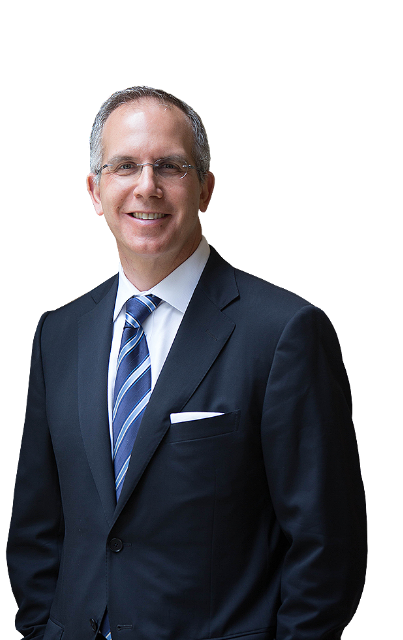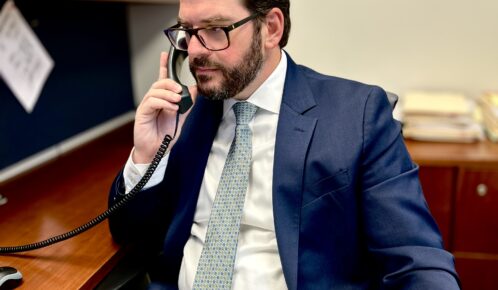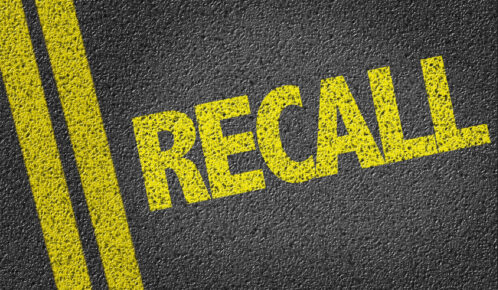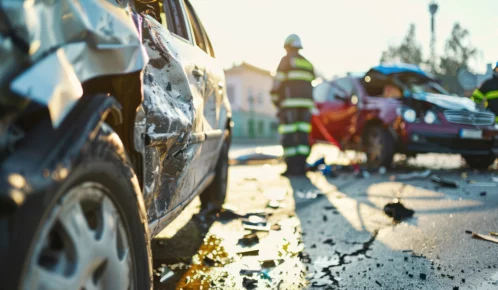ILLINOIS WORKERS’ COMPENSATION COMMISSION
NOTICE OF 19(b) DECISION OF ARBITRATOR
______xxxxx_________________
Employee/Petitioner
________xxxxx______________
Employer/Respondent
Case#”!.!
On 7/2/2012, an arbitration decision on this case was filed with the Illinois Workers’ Compensation Commission in Chicago, a copy of which is enclosed.
If the Commission reviews this award, interest of 0.15% shall accrue from the date listed above to the day before the date of payment; however, if an employee’s appeal results in either no change or a decrease in this award, interest shall not accrue.
A copy of this decision is mailed to the following parties:
xxxxxx
STATE OF ILLINOIS COUNTY OF COOK
D Injured Workers’ Benefit Fund (§4(d))
D Rate Adjustment Fund (§8(g))
D Second Injury Fund (§8(e)18)
None of the above
ILLINOIS WORKERS’ COMPENSATION COMMISSION
ARBITRATION DECISION
19(b)
____________________
Employee/Petitioner
Case#_·
v. Consolidated cases: ==
____________________
Employer/Respondent
An Application for Adjustment of Claim was filed in this matter, and a Notice of Hearing was mailed to each party. The matter was heard by the Honorable,, Arbitrator of the Commission, in the city of Chicago, IL May 8, 2012. After reviewing all of the evidence presented, the Arbitrator hereby makes findings on the disputed issues checked below, and attaches those findings to this document.
DISPUTED ISSUES
A. D Was Respondent operating under and subject to the Illinois Workers’ Compensation or Occupational Diseases Act?
B. D Was there an employee-employer relationship?
C. D Did an accident occur that arose out of and in the course of Petitioner’s employment by Respondent?
D. D What was the date of the accident?
E. D Was timely notice of the accident given to Respondent?
F. [g) Is Petitioner’s current condition of ill-being causally related to the injury?
G. D What were Petitioner’s earnings?
H. D What was Petitioner’s age at the time of the accident?
I. D What was Petitioner’s marital status at the time of the accident?
J. [g) Were the medical services that were provided to Petitioner reasonable and necessary? Has Respondent paid all appropriate charges for all reasonable and necessary medical services?
K. [g) Is P titioner entitled to any prospective medical care?
L. [g) What temporary benefits are in dispute?
D TPD D Maintenance [gl TTD
A. D Should penalties or fees be imposed upon Respondent?
B. D Is Respondent due any credit?
0. O other
ICArbDecl9(b) 2110 IOO W. Ra11dolph Street #8-200 Chicago. IL 6060I 3!2/814-66I IToll-free 866/352-3033Web site: www.iwcc.il.gov Downstate offices: Collii!Sville 6I8/346-3450 Peoria 309/67 I -3019 Rockford 815/987-7292 Springfield 217/185-7084
FINDINGS
On the date of accident, October 7, 2010, Respondent was operating under and subject to the provisions of the Act.
On this date, an employee-employer relationship did exist between Petitioner and Respondent.
On this date, Petitioner did sustain an accident that arose out of and in the course of employment.
Timely notice of this accident was given to Respondent.
Petitioner’s current condition of ill-being is causally related to the accident.
In the year preceding the injury, Petitioner earned $57,424.12; the average weekly wage was $1,104.31.
On the date of accident, Petitioner was 45 years of age, married with 4 dependent children.
Respondent has not paid all reasonable and necessary charges for all reasonable and necessary medical services.
Respondent shall be given a credit of $44,855.00 for TTD, $0.00 for TPD, $0.00 for maintenance, and $0.00 for other benefits, for a total credit of $44,855.00.
Respondent is entitled to a credit of $0.00 under Section 8G) of the Act.
ORDER
Respondent shall pay Petitioner temporary total disability benefits of $736.21/week for 82 6/7 weeks, commencing 1017110 through 5/8/2012, as provided in Section 8(b) of the Act.
Respondent shall be given a credit of $44,855.00 for temporary total disability benefits that have been paid.
Respondent shall pay the reasonable and necessary medical services incurred by Petitioner to date pursuant to Sections 8 and 8.2 of the Act.
The Petitioner is awarded and Respondent is to authorize the course of physical therapy and a hand surgery consult as recommended by Dr. 1 • and Dr. nd pay for all associated reasonable and necessary medical care.
In no instance shall this award be a bar to subsequent hearing and determination of an additional amount of medical benefits or compensation for a temporary or permanent disability, if any.
RULES REGARDING APPEALS Unless a party files a Petition for Review within 30 days after receipt of this decision, and perfects a review in accordance with the Act and Rules, then this decision shall be entered as the decision of the Commission.
STATEMENT OF INTEREST RATE If the Commission reviews this award, interest at the rate set forth on the Notice of Decision of Arbitrator shall accrue from the date listed below to the day before the date of payment; however, if an employee’s appeal results in either no change or a decrease in this award, interest shall not accrue.
– .,_.–,
Signature of Arbitrator l
!&/;;z
Date
JUL- 2 2012
FINDINGS OF FACT
Petitioner testified that he worked 7 years as a cab driver for Respondent. Accident and notice are not at issue. On 10/7/10, Petitioner was dispatched to a pick up while driving for Respondent. At the pickup location, Petitioner was shot in an attempted robbery of his cab. Specifically, Petitioner was shot in the left upper cervical area between the shoulder blade and the base of his neck. T. 9. The assailant was sitting in the back seat of the cab. T. 8.
Petitioner was taken to the ER atHospital where he stayed 3 days for the care and treatment of a gunshot wound to the neck and two broken ribs. The bullet traveled down internally and broke two ribs. T. 11. PX 2. Petitioner was taken off work.
Petitioner testified that after his release from: xxxxx in October 2010, he followed up with Dr. approximately 3 weeks later in November 2010 complaining of chest pain, rib pain and neck pain. The records from Dr. rat PX 3, do not reflect a visit in November 2010 or any visit in 2010. The first record of visit in 2011 is dated March 18, 2011 at which visit Petitioner complained of chest pain on the right side and was diagnosed with “chest pain bullet fragmentation right chest wall.” A chest x-ray and CT scan were ordered. PX 3. On May 20, 2011, Petitioner returned to Dr.and complained of left arm and shoulder pain and continued chest pain. Dr.ordered a CT scan of the chest and left shoulder. On July 15, 2011, the left shoulder CT scan was negative and the chest CT confirmed the bullet remaining in Petitioner’s chest. PX 3. On July 29, 2011, Dr.. noted tenderness over the left supraspinatus with a limited range of motion. Conservative care for the shoulder was continued.
On August 10, 2011, Petitioner saw the Respondent’s IME doctor, xxxx. Dr.’ noted Petitioner’s complaints of chest pain with deep breathing and left trapezius pain and proximal arm pain with lifting. In so noting, Dr. · writes, “This only began approximately two months ago, approximately seven to eight months after the injury.” Petitioner reported taking pain medication for the conditions and that he was able although reluctant to drive. RX 1. Physical exam of the left shoulder revealed a limited range of motion but Dr. · noted his opinion that Petitioner’ movements were guarded and that he was not fully participating in the exam. RX 1. Dr.· reviewed the July 15, 2011 left shoUlder CT scan and noted mild degenerative changes of the ac joint on the left without any other significant findings.
Dr. diagnosis was “(1) left shoulder pain of questionable etiology, not beginning until seven or eight months after the gunshot wound to the base of the neck … and (2) pleuritic occasional pain in the right side.” Dr. ; opined that the chest pain was causally related to the gun shot but that it was “unclear … whether the shoulder pain on the left is related to the injury. I think that it is likely not related as it did not occur, according to the patient himself, for seven months after the gunshot wound. It would be reasonable for there to be a mild amount of shoulder pain as the gunshot wound went through the left trapezial base, but this in no way is consistent with the onset of the symptoms or the magnitude of the symptoms which the patient is currently having.” Dr. commented that Petitioner had no physical therapy to date and that physical therapy was recommended for active and passive range of motion for both shoulders and strengthening. Finally, Dr. · stated that Petitioner could return to light duty work restricted from overhead work or driving for four weeks while he undergoes physical therapy. Thereafter he anticipated that Petitioner could be relapsed to work without restrictions. RX 1. Petitioner testified that he underwent four weeks of physical therapy at xxxx following his IME with Dr.·that slightly helped his left ann symptoms. T. 15-16.
On August 31, 2011 the Petitioner followed up with Dr. r , at which time Dr. referred the Petitioner to Dr. _ —-.— _ for possible excision of the bullet. PX 3. Petitioner was continued off work. The Petitioner again saw Dr. _ on September 28, 2011, where he again complained of left shoulder pain and was again referred to Dr. ‘and kept off work. The Petitioner testified that he saw Dr. . on October 6, 2011 and October 20, 2011 and that Dr. believed that the bullet could not be removed from the Petitioner’s chest cavity. RX 17.
On October 26, 2011 the Petitioner again saw Dr. , at which time he complained of continued left shoulder pain and was referred to another specialist to determine if the bullet could be removed. PX 3. Petitioner saw Dr. _ t on December 7, 2011 and complained of continued chest and left shoulder pain. Dr. . referred the Petitioner to Dr. Land continued him off work. PX 3.
On December 28, 2011 the Petitioner saw Dr. , and it was determined that the bullet could not be removed.,.;from the Petitioner’s chest cavity. PX 4. He noted Petitioner’s “predominant” complaint of pain, tingling and limited mobility of the left upper extremity mostly secondary to pain.” He advised Petitioner to work with Dr. . _l regarding left upper extremity complaints. PX 4.
On January 4, 2012 the Petitioner saw Dr. f _ . at which time an EMG/NCV of the left upper extremities was ordered ”to characterize the cause of the paresthesia.” Dr. _ also noted left hand paresthesia. On January 6, 2012, Dr.’ _ wrote “To Whom it may concern: In the months following …gunshot wound to the base of the neck, he had a progressively worsening left shoulder pain with parasthesia in his left upper extremity. We need EMG/NCV of his upper extremities to … the nature of his nerve damage.”
On February 2, 2012, Respondent’s IME Dr.’ drafted an addendum report. RX 2. In it, he noted Dr. ‘s recent recommendation for an EMG/NCV due to left shoulder pain and determined that no additional testing was necessary. He placed Petitioner at MMI. Further, he stated that did not see any anatomic reason Petitioner could not drive but since Dr. is unable to “clear” people to work, he recommended a driving based FCE to determine Petitioner’s ability to return to work as a driver. RX 2.
On April24, 2012 the Petitioner underwent an EMG/NCV with Dr. PX 5. The EMG/NCV results were abnormal and revealed brachial plexopathy, superimposed left cubital tunnel and mild carpal tunnel on the left. Dr. . – opined that the “plexopathy changes are acute to chronic and much of the repair to be expected for the patient in terms of axon recovery usually happens in the first 6mths to a year. Given that his GSW is 2 years off, the likelihood of continued axon repair diminishes the longer out from the date of injury he is. The inferior trunk/medial cord derived nerves also correspond greatly to the C8-Tl nerve roots, which explains for the nerve conductions seen as there are amplitudes lost in the ulnar distributions explaining for the ulnar pathology at the elbow/wrist and for the parasthesias he feels in the medial hand. Recommend elbow flexion-prevention brace if the patient’s cubital tunnel syndrome symptoms persists on the left. Should have aggressive PT For the left shoulder if he wished to gain additional strength, …, and the PT will help improve some of his impingement signs he is developing in the shoulder that is causing his joint pain. He is at risk for developing adhesive capsulitis if the ROM does not improve.” Furthermore, the patient should have a wrist splint ordered for both wrists for CTS prevention. The right side although not directly affected during the GSW is a classic finding with patient’s [sic] who have asymmetry of ADL function due to injury of the left side, and he is likely over compensating use of his right hand, which has caused him to develop this severe carpal tunnel syndrome on the right. He should at minimum have referral to hand surgery for evaluation as the conductions meet minimum criteria for possible carpal tunnel release surgery, however given his job as a taxi driver, the patient may opt to try conservative management as he depends on bilateral hand function in order to operate his vehicle for work.” PX 5.
Petitioner testified that he saw Dr. _ . on May 4, 2012. T. 21. Dr. , recommended physical therapy for the left shoulder and a referral to a hand surgery for the right hand. Petitioner was continued off work.
Petitioner testified that he had no injuries prior to his undisputed October 7, 2010 work accident. T. 23. Petitioner testified that he continues to have pain and numbness in his left arm as of the date of trial and is unable to lift his left arm. T. 22. Petitioner testified that if awarded the physical therapy and hand surgery consult, he would have them both performed immediately. RX 22-23. The Petitioner testified that he continues to receive medical bills in the mail. Petitioner has not received temporary total disability benefits since December 1, 2011. ARB EX 1.
On cross-examination the Petitioner testified that he is unable to drive a cab due to his inability to use his left arm to do other things beside drive. He is unable to pick up a passengers wheel chair to put it in the trunk and also testified that he is unable to maneuver the cab with both hands making it dangerous for customer. T. 25. Finally, Petitioner testified that he started and invested in a company named
in January 2010 that opened in Gary, IN. T. 26. The company never made any product due to Petitioner’s inability to work there following his injury so the company was shut down by the USDA due to inactivity. T. 27. He testified that this company was supposed to be in the business of selling beef jerky. T. 29.
With regard to his driving abilities, Petitioner testified on cross examination that he does operate his own vehicle but that he has not been cleared to drive a cab. T. 33-34, 41. He testified that in order to drive a cab, the City of Chicago requires him to complete a driving program/physical exam, which he is unable to complete due to his injuries. T. 34. Specifically, the Petitioner testified that he cannot lift luggage or aide a disabled person as required due to his left shoulder injury. T. 34-35. Petitioner testified that he has not voluntarily sought or tried to take the clearance exam in that he is sure he will not pass it due to his left arm.
The Respondent produced three witnesses at trial: Mr. x, Mr. y and Mr. z. 48, 69 and 77. These witnesses were called in order to lay a proper evidentiary foundation for RX 3, 4, and 5, a surveillance video, surveillance report, and surveillartce report summary, respectively. The video presented into evidence as RX 3 represents the three days of surveillance in which the Petitioner was observed. RX 3. The Arbitrator has viewed RX 3 and notes that while Petitioner is on camera he is observed to be using only his right arm to open doors and carry items. Notably,-·Petitioner is seen reaching across his body to shut the car door with his right hand in place of using his left hand.
CONCLUSIONS OF LAW
The foregoing findings of fact are incorporated into the following conclusions of law.
F. Is Petitioner’s current condition of ill-being casually related to the injury?
Based on the evidence submitted at trial as well as Petitioner’s credible trial testimony, the Arbitrator finds that Petitioner’s condition of ill-being in his left arm is causally related to the accident of 10/7110 when Petitioner received a gunshot wound to the left side of his lower neck. The Petitioner sought medical .treatment immediately following his October 7, 2012 work accident for the gunshot wound and for its sequelae including chest pain. The Arbitrator notes that Petitioner received consistent care for the chest pain immediately after the accident with the first specific complaint of left shoulder pain or symptoms on 5/20111, 7 months after the shooting. The significance of the delay in complaint is not lost on the Arbitrator. However, the delay in complaint in the instant matter does not entirely detract from Petitioner’s credibility in light of the nature of his initial injury – gunshot to the left neck- and the proximity of his current complaints to the neck area where he was shot.
Specifically, the Arbitrator finds the opinion of Dr. . _ plausible and logical given the nature of the injury. Dr. read the EMG/NCV to reveal brachial plexopathy, superimposed left cubital tunnel and mild carpal tunnel on the left. Dr. – < opined that the “plexopathy changes are acute to chronic and much of the repair to be expected to for the patient in terms of axon recovery usually happens in the first 6mfus to a year. Given that his GSW is 2 years off, the likelihood of continued axon repair diminishes the longer out from the date of injury he is. The inferior trunk/medial cord derived nerves also correspond greatly to the C8-T1 nerve roots, which explains for the nerve conductions seen as there are amplitudes lost in the ulnar distributions explaining for the ulnar pathology at the elbow/wrist and for the parasthesias he feels in the medial hand. Recommend elbow flexion-prevention brace if the patient’s cubital tunnel syndrome symptoms persists on the left. Should have aggressive PT For the left shoulder if he wished to gain additional strength, …, and the PT will help improve some of his impingement signs he is developing in the shoulder that is causing his joint pain. He is at risk for developing adhesive capsulitis if the ROM does nor-improve.” The Arbitrator finds this opinion more plausible and thus assigns greater weight to this opinion than to the opinion offered by IME Dr. · rendered prior to the EMG/NCV study completed in May 2012.
The Arbitrator further finds that Petitioner’s current condition of right sided carpal tunnel is also causally related to the accident. In so finding, the Arbitrator notes the opinion of Dr. f _ who opined that Petitioner’s current diagnosis of right sided carpal tunnel syndrome is due to the Petitioner’s overcompensation for his inability to use his left arm. The surveillance video depicts Petitioner as not using his left arm in any meaningful way. Petitioner used his right arm for every activity depicted thus lending support to his credibility and buttressing the opinion of Dr. ·
For these reasons, the Arbitrator finds that the Petitioner’s current condition of ill-being in his left shoulder and right arm is causally related to his undisputed October 7, 2010 work injury.
J. K. Were the medical services that were provided to Petitioner reasonable and necessary? Has Respondent paid all appropriate charges for all reasonable and necessary medical services? Is Petitioner entitled to any prospective medical care?
Based on the findings of causal connection in this matter, the Arbitrator further finds that the Petitioner’s treatment has been both reasonable and necessary and that the Respondent has not paid all appropriate charges. The Petitioner was shot in the back of the neck in an undisputed work accident on October 7, 2010. The bullet traveled through the Petitioner’s body, damaging nerves, fracturing a rib on the right side of the Petitioner’s torso, bruising a lung, and coming to rest in the right side of the Petitioner chest cavity. As a result the Petitioner has had doctors’ visits, diagnostic testing, pain medication, and a course of physical therapy. To date the Petitioner has complaints primarily of pain in the left shoulder. The Petitioner underwent an EMG/NCV test in order to more accurately diagnose the Petitioner’s condition which revealed brachial plexopathy. The Arbitrator finds that the treatment received by the Petitioner has been conservative and has been both reasonable and necessary in light of the significant injuries the Petitioner sustained. Further, the Petitioner produced at trial outstanding medical bills. PX 1. These bills have not been paid by the Respondent and are hereby awarded.
Further, based on the foregoing findings as well as on the opinions of Dr. md ( a, the Arbitrator finds that Petitioner is entitled to prospective medical care in the form of physical therapy and a hand surgery consult. Dr. i Land Dr. F · _._’ t ·;l have both opined that the Petitioner is in need of further medical care based on the results of the .tMG/NCV revealing brachial plexopathy and carpal tunnel syndrome in his right wrist from overcompensating due to the brachial plexopathy. PX 5. Petitioner is therefore awarded physical therapy and a hand surgery consult as recommended by Dr. r – L and J – · ‘1 along with all accompanying reasonable and necessary medical treatment.
L. What temporary benefits are in dispute? TTD
The Arbitrator finds that Petitioner was authorized off work as of 10/7/10 and has not been returned to work by his treating physician.The Arbitrator notes that Dr. also determined that Petitioner’s condition did not support a driving job – at least not without a specialized driving FCE or additional physical therapy. Petitioner attended additional physical therapy but was still not released to cab driving. Petitioner testified that he is not able to perform the physical functions he needs to pass the City exam to drive nor is he able to personally handle passengers or their equipment with the use of only one arm. Finally, the Arbitrator notes the Petitioner can and does drive his personal vehicle as seen on the surveillance video. However, the Arbitrator notes that he is in fact driving his personal car and not performing the type of commercial driving required of a cab driver or driving with concern for the safety of passengers. The Arbitrator finds that the Petitioner is not capable of work as he has not been cleared to return.
The fact’”‘that Petitioner is still able to drive does not equate to having the ability to drive a cab for a living. The Petitioner remains temporarily totally disabled. The Arbitrator awards TTD benefits for the period of 82-6/7 weeks commencing 10/7/10 through 5/8/12.
Finally, the Arbitrator finds no support in the record for the argument that Petitioner is not entitled to TTD because he was in fact working at G – – –after his accident. The business never got off the ground and was closed before it ever opened due in part to Petitioner’s inability to work at that business.



